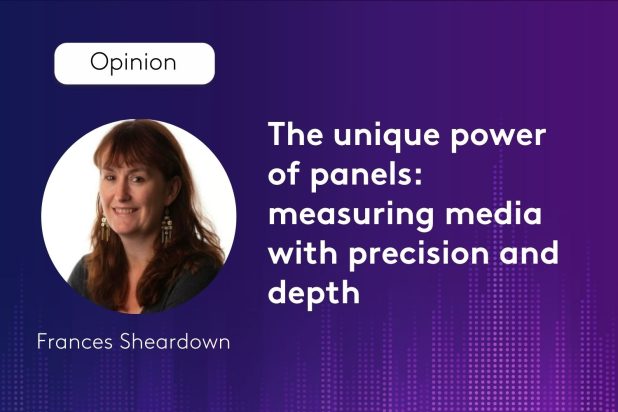As the media world fragments and the competition for audience attention intensifies, the unique insights provided by panels become more valuable than ever, writes Frances Sheardown

In recent years, there has been a renewed appreciation for the value of panels in audience measurement. Despite the rise of big data, panels – which are fundamental to people-powered measurement – have always been a vital tool for many leading businesses on both the media owner and buyer sides. Now, a new wave of businesses is recognising their importance too. Instead of making a binary choice, they are discovering that combining panels with big data is often key to achieving more comprehensive audience insights.
Consisting of carefully selected and managed groups of individuals or households, panels provide critical insights that help media companies, advertisers, and content creators understand not just what is being consumed, but also who is consuming it, how, and with whom. Unlike big data, panels provide the person-level understanding of media consumption and advertising effectiveness.
By contrast, big data represents an extensive collection of both structured and unstructured data that can be harnessed to discover patterns, trends, and correlations. It enables a comprehensive view of the media landscape, capturing details about audience size, consumption habits, and market movements. Additionally, big data supports real-time processing, allowing advertisers to modify their strategies in response to ongoing events or market shifts. It also facilitates predictive analytics, where historical data is analysed to forecast future trends and consumer behaviour, and aids in personalising advertising experiences by targeting specific individuals with tailored messages.
But here’s the thing: measurement panels serve as a crucial calibration tool for big data, making them ideal bedfellows rather than a binary choice. While big data offers a broad, often incomplete view of audience behaviour, panels provide a smaller, more precise snapshot of a representative group. By comparing these two data sets, discrepancies can be identified and corrected, ensuring that the big data picture accurately reflects the overall population. This process enhances the reliability and validity of big data insights.
For example, by integrating panel data with server logs or ad server data, media companies can enhance their understanding of how content is consumed by real people across different devices and platforms.
Furthermore, panels are also instrumental in training large data sets, a process known as fusion. This approach allows disparate data sources to be combined accurately, creating a comprehensive view of media consumption that supports more effective media planning and buying strategies.
This integration is also particularly important in a post-cookie world. As the industry shifts away from cookie-based tracking, the importance of compliant, consent-based panel data grows. Panels provide a privacy-safe way to maintain a continuous consumer signal, crucial for navigating the increasing privacy regulations and the fading efficacy of traditional tracking methods.
A people-centric approach to measurement
At the heart of the value proposition offered by audience panels is their people-centric nature, which provides essential demographic and behavioural insights. For instance, panels can differentiate whether a streamed show on a family TV is being watched by a parent alone or with their children. This level of detail is invaluable for creating content and advertisements that resonate more deeply with diverse audiences. Afterall, devices don’t watch TV; people do.
Indeed, only panels can address the critical issue of co-viewing, which large data sets often overlook. Traditional metrics might count a single view, irrespective of whether one person or an entire family watched it. Panels, however, can accurately report on multiple viewers, providing a clearer picture of the true reach and impact of content and ads.
Future-proofing media measurement
Looking ahead, the role of panels is set to become even more significant. For starters, they are continuously evolving, employing more sophisticated technology and methods as media consumption habits change. This adaptability ensures that panels can keep pace with new platforms and technologies.
For instance, the granularity of panels is improving through the integration of first-party data, giving businesses a more comprehensive view for informed decision-making. So while streaming, set-top box, and ACR data offer detailed insights into specific services, panels are helping to bridge the gaps and capture the full spectrum of consumers’ media experiences, delivering valuable strategic and tactical insights.
Panels also underpin cross-platform measurement, and form the backbone of Project Origin – which breaks new ground by providing a unified way to track and measure audience engagement across devices and platforms. In partnership with ISBA, Kantar Media will use the linked insights to offer a much more accurate and detailed understanding of audience behaviours across multiple media environments.
As the media world becomes more fragmented and the competition for audience attention intensifies, the insights provided by panels are therefore more valuable than ever. They offer a depth and fidelity of data that other forms of measurement and data alone simply cannot match.
Panels are indispensable measurement tools for anyone seeking to understand and engage with today’s complex media environment.
To find out more about how panels can support your business, download a copy of Kantar Media’s People-Powered Measurement guide.